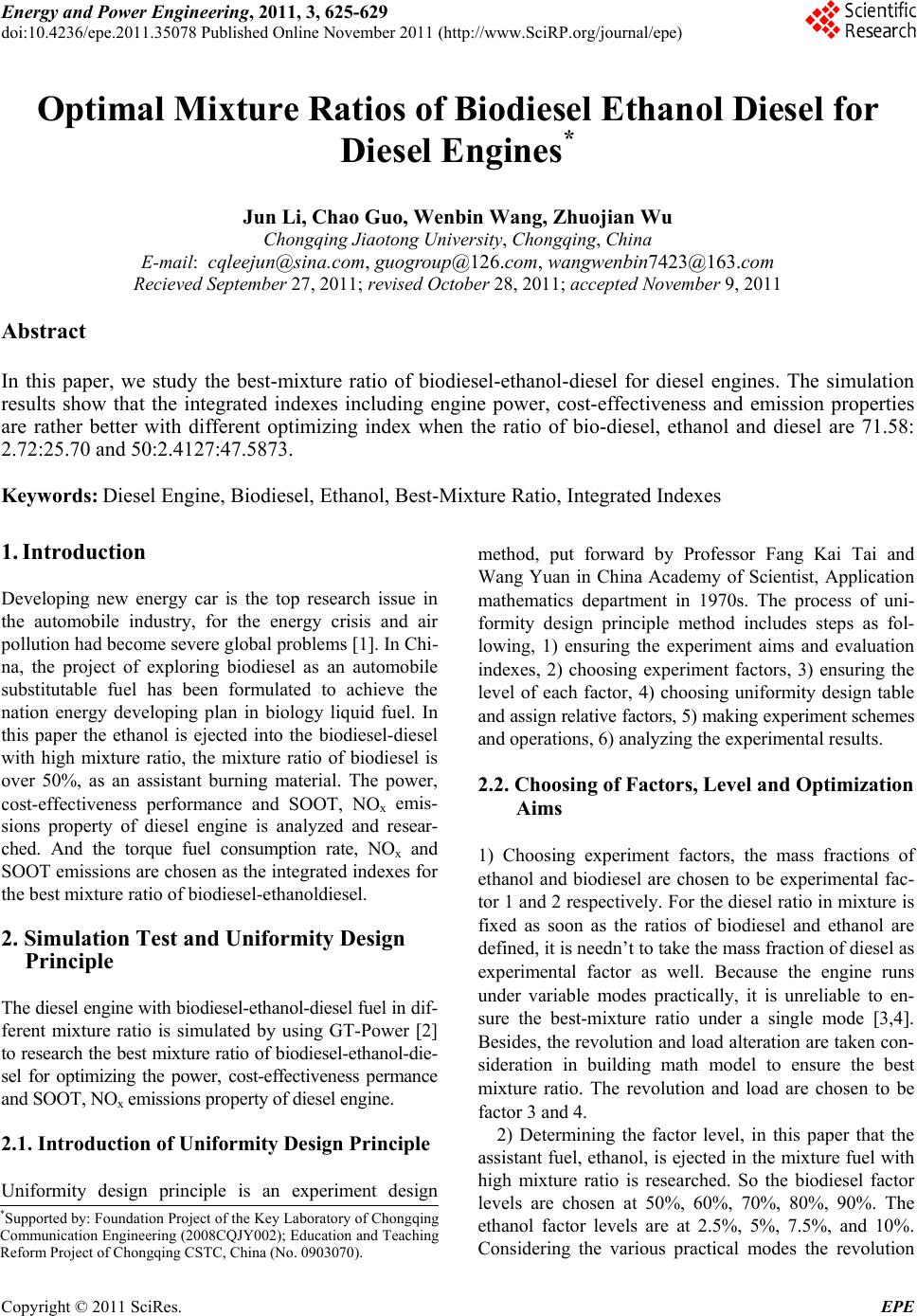
Energy and Power En gi neering, 2011, 3, 625-629
doi:10.4236/epe.2011.35078 Published Online November 2011 (http://www.SciRP.org/journal/epe)
Copyright © 2011 SciRes. EPE
Optimal Mixture Ratios of Biodiesel Ethanol Diesel for
Diesel Engines*
Jun Li, Chao Guo, Wenbin Wang, Zhuojian Wu
Chongqing Jiaotong University, Chongqing, China
E-mail: cqleejun@sina.com, guogroup@126.com, wangwenbin7423@163.com
Recieved September 27, 2011; revised October 28, 2011; accepted November 9, 2011
Abstract
In this paper, we study the best-mixture ratio of biodiesel-ethanol-diesel for diesel engines. The simulation
results show that the integrated indexes including engine power, cost-effectiveness and emission properties
are rather better with different optimizing index when the ratio of bio-diesel, ethanol and diesel are 71.58:
2.72:25.70 and 50:2.4127:47.5873.
Keywords: Diesel Engine, Biodiesel, Ethanol, Best-Mixture Ratio, Integrated Indexes
1. Introduction
Developing new energy car is the top research issue in
the automobile industry, for the energy crisis and air
pollution had become severe global problems [1]. In Chi-
na, the project of exploring biodiesel as an automobile
substitutable fuel has been formulated to achieve the
nation energy developing plan in biology liquid fuel. In
this paper the ethanol is ejected into the biodiesel-diesel
with high mixture ratio, the mixture ratio of biodiesel is
over 50%, as an assistant burning material. The power,
cost-effectiveness performance and SOOT, NOx emis-
sions property of diesel engine is analyzed and resear-
ched. And the torque fuel consumption rate, NOx and
SOOT emissions are chosen as the integrated indexes for
the best mixture ratio of biodiesel-ethanoldiesel.
2. Simulation Test and Uniformity Design
Principle
The diesel engine with biodiesel-ethanol-diesel fuel in dif-
ferent mixture ratio is simulated by using GT-Power [2]
to research the best mixture ratio of biodiesel-ethanol-die-
sel for optimizing the power, cost-effectiveness permance
and SOOT, NOx emissions property of diesel engine.
2.1. Introduction of Uniformity Design Principle
Uniformity design principle is an experiment design
method, put forward by Professor Fang Kai Tai and
Wang Yuan in China Academy of Scientist, Application
mathematics department in 1970s. The process of uni-
formity design principle method includes steps as fol-
lowing, 1) ensuring the experiment aims and evaluation
indexes, 2) choosing experiment factors, 3) ensuring the
level of each factor, 4) choosing uniformity design table
and assign relative factors, 5) making experiment schemes
and operations, 6) analyzing the experimental results.
2.2. Choosing of Factors, Level and Optimization
Aims
1) Choosing experiment factors, the mass fractions of
ethanol and biodiesel are chosen to be experimental fac-
tor 1 and 2 respectively. For the diesel ratio in mixture is
fixed as soon as the ratios of biodiesel and ethanol are
defined, it is needn’t to take the mass fraction of diesel as
experimental factor as well. Because the engine runs
under variable modes practically, it is unreliable to en-
sure the best-mixture ratio under a single mode [3,4].
Besides, the revolution and load alteration are taken con-
sideration in building math model to ensure the best
mixture ratio. The revolution and load are chosen to be
factor 3 and 4.
2) Determining the factor level, in this paper that the
assistant fuel, ethanol, is ejected in the mixture fuel with
high mixture ratio is researched. So the biodiesel factor
levels are chosen at 50%, 60%, 70%, 80%, 90%. The
ethanol factor levels are at 2.5%, 5%, 7.5%, and 10%.
Considering the various practical modes the revolution
*Supported by: Foundation Project of the Key Laboratory of Chongqing
Communication Engineering (2008CQJY002); Education and Teaching
Reform Project of Chongqing CSTC, China (No. 0903070).